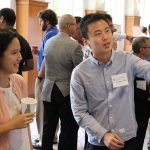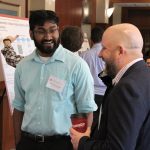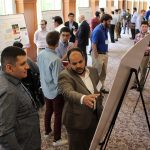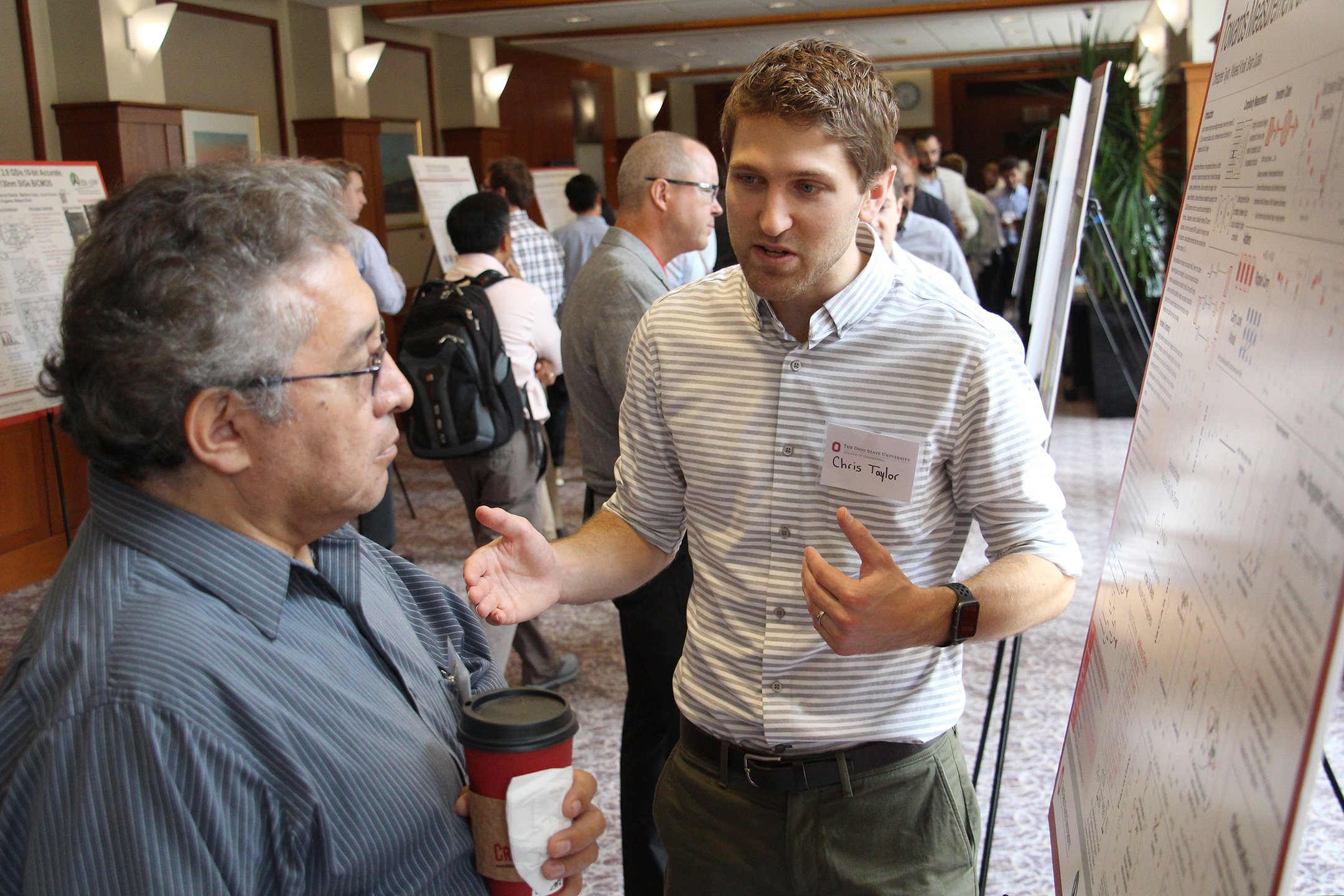 Student researchers from the ElectroScience Laboratory (ESL) at The Ohio State University shared their work on cutting-edge electromagnetics and radio frequency research with representatives from some of the top industries in the country at the 9th-annual CERF Technical Meeting and Affiliates Dinner.
Student researchers from the ElectroScience Laboratory (ESL) at The Ohio State University shared their work on cutting-edge electromagnetics and radio frequency research with representatives from some of the top industries in the country at the 9th-annual CERF Technical Meeting and Affiliates Dinner.
CERF, or the Consortium on Electromagnetics and Radio Frequencies, is an alliance allowing ESL faculty, researchers and students to share their expertise with top U.S.-based industries.
The event gives industry access to the potential workforce talent at ESL, one of the top research centers worldwide in the realms of electromagnetics and radio frequency research.
This year, ESL welcomed representatives from BAE Systems, the BerrieHill Research Division of Applied Research Associates, Bridgestone Americas, Lockheed Martin, MIT Lincoln Laboratory, Northrop Grumman and Raytheon to the Blackwell Inn and Pfahl Conference Center at Ohio State on August 7.
“CERF has many benefits for our industrial affiliates as well as our students and researchers at ESL. The affiliates gain access to our students and their research, our lab facilities, and can even support research projects at ESL,” said interim director Bob Burkholder. “The annual meeting is an excellent opportunity for the students to showcase their work and gain experience making presentations. They also get the chance to interact with potential sponsors and future employers.”
Forty-six posters were presented in four technical areas: radar, navigation and sensing; electromagnetic algorithms and measurements; radio-frequency circuits and optics; and antenna design.
The majority of presenters were ESL graduate students, with quite a few showcasing their thesis research.
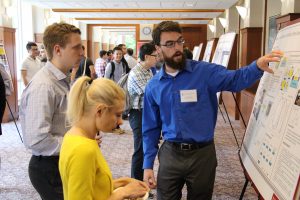 For Lucas Newton, a first-year ESL graduate student studying electromagnetics, the event was more than an opportunity to share his work with industry representatives.
For Lucas Newton, a first-year ESL graduate student studying electromagnetics, the event was more than an opportunity to share his work with industry representatives.
It was a chance to spark a professional relationship.
Newton spent an extra 10 minutes after the the closing session talking one-on-one with a representative from global security and aerospace company Lockheed Martin. Fifteen minutes earlier he won third place for his engaging presentation of “Reconfigurable Multiband FarIR Notch Filter Employing Phase Change Material.”
To him, the benefit of effectively communicating his work is obvious.
“Communication needs to be strong. It’s at the top of my list of things that I need to be able to do,” Newton said. “Otherwise, no one is going to hear about it. You have to be able to tell someone what you are doing. You have to spread the word.”
Closing the technical meeting, judging industry affiliates awarded six poster presenters for their presentations. The 2018 ESL-CERF Poster Session Winners are listed below.
First Place: Ahmed Naguib Mohamed for “High Resolution, Wide Bandwidth and Multi-mode Arbitrary Waveform Generator (AWG) for Telemetry Applications.” Co-authors: Mo’men Abusareya, Luke Duncan, Brian Dupaix, Matt Larue, Eslam Yahya, Shane Smith (advisor), and Waleed Khalil (advisor).
Second Place (tie): Mark J. Andrews for “The Ultra-Wideband Software Defined Radiometer (UWBRAD) for Internal Ice Sheet Sensing: Recent Results and Campaign Planning.” Co-authors: Joel T. Johnson (advisor), Hongkun Li, Mustafa Aksoy, and Kenneth Jezek.
Second Place (tie): Jack Eichenberger for “High Gain UWB Antipodal Vivaldi Antenna for 2.5-57 GHz Applications.” Co-author: Nima Ghalichechian (advisor).
Third Place: Lucas Newton for “Reconfigurable Multiband FarIR Notch Filter Employing Phase Change Material.” Co-authors: Varittha Sanphuang and Niru K. Nahar (advisor).
Fourth Place: Julio L. Nicolini for “Recent Results on Finite-Element-based Particle-in-Cell Methods for Kinetic Plasma Simulations.” Co-authors: Dong-Yeop Na, Yuri A. Omelchenko and Fernando L. Teixeira (advisor).
Fifth Place: Daniel Ospina Acero for “Automatic Synthetic Electrode Selection for Uncertainty Reduction in Capacitive Sensing Using Adaptive Relevance Vector Machine.” Co-authors: Fernando Teixeira (advisor) and Qussai Marashdeh.
On top of connecting industry and academia, the ESL consortium gives member companies access to state-of-the-art facilities, faculty and student researchers, as well as specialty training courses that are tailored toward member needs.
ESL also hosts the annual Consortium of Ohio Universities on Navigation and Timekeeping, or COUNT, in which members hold informational meetings and deliver short courses providing system-level training to navigation professionals. The consortium presents the latest research findings and offers early industry exposure to graduating students.
At Ohio State, ESL is a center of excellence focused on all aspects of wireless communications and electro-optics, including remote sensing, radar signal processing, sensors and sensor fusion, antennas, radio frequency (RF) integrated circuits, terahertz, millimeter waves, optics and photonics.
The Institute for Materials Research is an interdisciplinary institute that works across colleges and departments at The Ohio State University to facilitate, promote and coordinate research and infrastructure related to the science and engineering of materials.
Follow: @OhioStateIMR
Story by Mike Huson, IMR Public Relations Coordinator
Contact: huson.4@osu.edu

